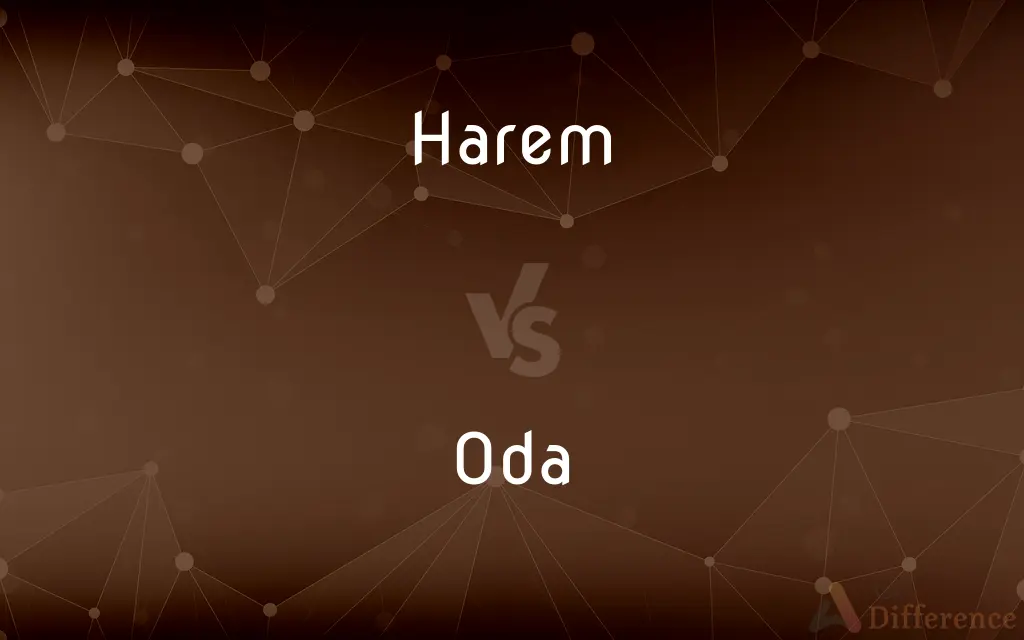Harem vs. Oda — What's the Difference?
Edited by Tayyaba Rehman — By Maham Liaqat — Updated on April 25, 2024
Harem refers to a secluded living area for women in some Muslim households, emphasizing privacy, while Oda is a term for a room or suite in an Ottoman architecture context, often part of a harem.

Difference Between Harem and Oda
Table of Contents
ADVERTISEMENT
Key Differences
The concept of a harem involves a private space within a household reserved exclusively for the women of the family, reflecting cultural norms around gender and privacy. On the other hand, an Oda specifically describes any room or suite within Ottoman architecture, which could be part of a harem or any other section of a large residence or public building. This distinction highlights the different scopes of these terms, where 'harem' has a social and cultural implication, whereas 'Oda' is more architectural.
Harems are typically associated with historical practices in Islamic cultures, particularly in the context of royal or noble households, where multiple wives, concubines, and female servants lived. In contrast, Odas are used more broadly to refer to rooms used for various purposes, including sleeping, meeting, or administrative functions, in traditional Ottoman buildings.
In literature and popular culture, harems often symbolize secrecy and the separation of women from public life. Meanwhile, Oda does not carry these connotations and is simply a term for a room, reflecting its neutral role in architectural terminology.
Security measures and restrictions are integral to harems, designed to protect the privacy of the women living there from the outside world. Conversely, an Oda might be open to a wider range of occupants and uses, depending on its location within a building and the cultural context.
The design and decoration of harems can be quite elaborate, aimed at providing comfort and luxury to its inhabitants. Whereas the design of an Oda can vary widely, from simple and functional to ornate, depending on its intended use and the status of the occupants.
ADVERTISEMENT
Comparison Chart
Definition
Private space for women in Muslim households
Room or suite in Ottoman architecture
Cultural Significance
Symbolizes gender separation and privacy
Lacks specific cultural connotations
Usage Context
Residential, specifically for women
Residential or administrative
Associated Architecture
Islamic
Ottoman
Public Access and Privacy
Highly restricted and private
Varies, often less restricted
Compare with Definitions
Harem
Often a space of both restriction and luxury.
Although the harem was opulent, the women inside had limited freedom.
Oda
Architecturally distinct, sometimes featuring elaborate decorations.
The Oda was adorned with intricate tile work and luxurious carpets.
Harem
Symbolic of female seclusion and privacy within a household.
The harem was strictly off-limits to male visitors.
Oda
Not limited to residential use; also includes administrative functions.
The administrative Oda housed the estate's management staff.
Harem
A group of women associated with one man, historically in polygamous contexts.
The sultan's harem consisted of several wives and concubines.
Oda
A room in traditional Ottoman architecture, often part of a larger complex.
The grand vizier conducted meetings in the central Oda.
Harem
Refers to the practice of housing women separately in historical Islamic societies.
The harem system was a common feature in medieval Islamic empires.
Oda
Neutral in terms of gender and cultural connotations.
Visitors were shown into a lavishly decorated Oda for tea.
Harem
A section of a house reserved for women in Muslim cultures.
The royal palace featured a luxurious harem secluded from the public areas.
Oda
Can serve various purposes, from bedrooms to meeting rooms.
The upper floor contained several Odas used for the family's private affairs.
Harem
Harem (Arabic: حريم ḥarīm, "a sacred inviolable place; harem; female members of the family") properly refers to domestic spaces that are reserved for the women of the house in a Muslim family. This private space has been traditionally understood as serving the purposes of maintaining the modesty, privilege, and seclusion of women from other men.
Oda
A room within a harem
Harem
A house or a section of a house reserved for women members of a Muslim household.
Harem
The wives, concubines, female relatives, and servants occupying such a place.
Harem
A group of female animals that breed exclusively with a single dominant male.
Harem
The private section of an Arab household, traditionally forbidden to male strangers.
Harem
A group of someone's girlfriends, wives and/or concubines in a polygamous household.
Harem
A group of female animals (cows) herded and controlled by a male animal (bull) of that species for breeding purposes. Such behaviour is exhibited by bovids including cattle and buffalo as well as moose, elephants, seals, sea lions, baboons, and elephant seals.
Harem
(ornithology) A group of female birds mated to or associated with a breeding male.
Harem
(slang) Any significant number of women together as a group; a bevy.
Harem
(uncountable) A genre of anime and manga in which a man is the love interest of three or more women.
Harem
The apartments or portion of the house allotted to females in Mohammedan families.
Harem
The family of wives and concubines belonging to one man, in Mohammedan countries; a seraglio.
Harem
Living quarters reserved for wives and concubines and female relatives in a Muslim household
Common Curiosities
Are harems common in modern buildings?
Harems are rare in modern architecture and are mostly seen in historical contexts.
Can anyone enter an Oda in a traditional Ottoman building?
Access to an Oda depends on its function and location, but it is generally more accessible than a harem.
How does the purpose of an Oda differ from other rooms?
An Oda's purpose can be versatile, unlike other rooms which might be designed for specific activities.
How is an Oda used in Ottoman architecture?
An Oda can serve multiple functions, such as a bedroom, meeting room, or administrative space in Ottoman architecture.
What is the cultural significance of a harem?
Harems have cultural significance related to gender roles and privacy in Islamic societies.
How does the concept of privacy differ between a harem and an Oda?
Privacy is paramount in a harem, designed specifically for seclusion, whereas an Oda's level of privacy can vary.
What is the primary function of a harem?
The primary function of a harem is to provide a secluded space for the women of a Muslim household.
Do all Ottoman buildings include an Oda?
Most traditional Ottoman buildings include one or more Odas, as they are a standard element of this architectural style.
Is the design of a harem different from other parts of a house?
Yes, harems are often more elaborately decorated and designed for comfort and privacy.
What materials are typically used in constructing an Oda?
Traditional materials like wood, stone, and ornamental tiles are commonly used in constructing an Oda.
Who decides the occupants of a harem?
The head of the household, typically the male patriarch, decides the occupants of a harem.
Can an Oda be found in non-residential buildings?
Yes, Odas can be found in various buildings, including governmental and religious structures.
What architectural styles influence the design of a harem?
Islamic architectural styles, emphasizing ornate details and spatial hierarchy, influence the design of a harem.
What kind of people would typically live in a harem?
Typically, the wives, concubines, and female servants of the household's patriarch would live in a harem.
Are there modern equivalents to a harem in contemporary architecture?
Modern equivalents are rare, but some homes may have private areas that serve a similar function.
Share Your Discovery

Previous Comparison
Salvage vs. Recovery
Next Comparison
Intertext vs. HypertextAuthor Spotlight
Written by
Maham LiaqatEdited by
Tayyaba RehmanTayyaba Rehman is a distinguished writer, currently serving as a primary contributor to askdifference.com. As a researcher in semantics and etymology, Tayyaba's passion for the complexity of languages and their distinctions has found a perfect home on the platform. Tayyaba delves into the intricacies of language, distinguishing between commonly confused words and phrases, thereby providing clarity for readers worldwide.
















































